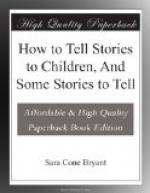From these four instances we may, perhaps, deduce certain general principles of adaptation which have at least proved valuable to those using them.
These are suggestions which the practised story-teller will find trite. But to others they may prove a fair foundation on which to build a personal method to be developed by experience. I have given them a tabular arrangement below.
The preliminary step in all cases is
Analysis of the Story.
The aim, then, is
to reduce a long story or to amplify
a short one.
For the first, the need is
Elimination of secondary threads
of narrative,
extra
personages,
description,
irrelevant
events.
For the second, the great need is of
Realising Imagination.
For both, it is desirable to keep
Close Logical Sequence, A Single Point of View, Simple Language, The Point at the End.
CHAPTER IV
HOW TO TELL THE STORY
Selection, and, if necessary, adaptation—these are the preliminaries to the act of telling. That, after all, is the real test of one’s power. That is the real joy, when achieved; the real bugbear, when dreaded. And that is the subject of this chapter, “How to tell a story.”
How to tell a story: it is a short question which demands a long answer. The right beginning of the answer depends on a right conception of the thing the question is about; and that naturally reverts to an earlier discussion of the real nature of a story. In that discussion it was stated that a story is a work of art,—a message, as all works of art are.
To tell a story, then, is to pass on the message, to share the work of art. The message may be merely one of humour,—of nonsense, even; works of art range all the way from the “Victory” to a “Dresden Shepherdess,” from an “Assumption” to a “Broken Pitcher,” and farther. Each has its own place. But whatever its quality, the story-teller is the passer-on, the interpreter, the transmitter. He comes bringing a gift. Always he gives; always he bears a message.
This granted, the first demand of the story-teller is not far to seek. No one can repeat a message he has not heard, or interpret what he does not understand. You cannot give, unless you first possess. The first demand of the story-teller is that he possess. He must feel the story. Whatever the particular quality and appeal of the work of art, from the lightest to the grandest emotion or thought, he must have responded to it, grasped it, felt it intimately, before he can give it out again. Listen, humbly, for the message.




